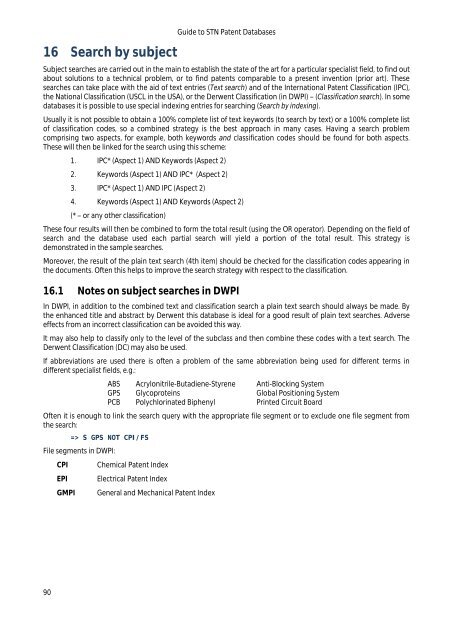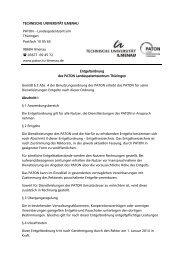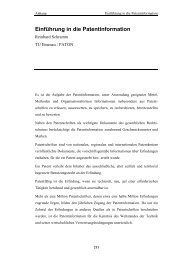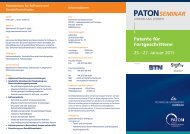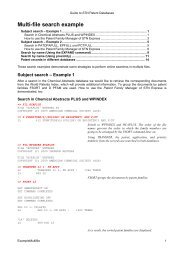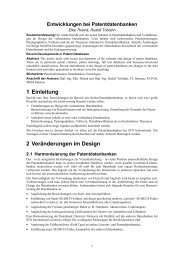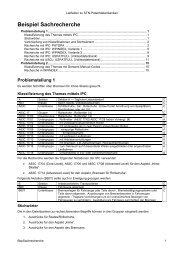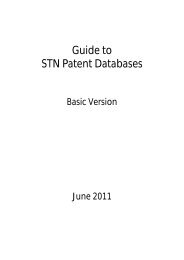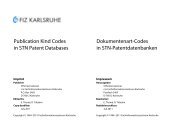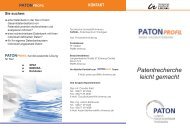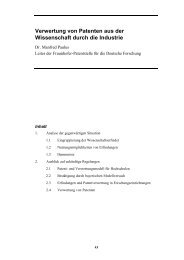Guide to STN Patent Databases – Basic Version - Paton - TU Ilmenau
Guide to STN Patent Databases – Basic Version - Paton - TU Ilmenau
Guide to STN Patent Databases – Basic Version - Paton - TU Ilmenau
You also want an ePaper? Increase the reach of your titles
YUMPU automatically turns print PDFs into web optimized ePapers that Google loves.
16 Search by subject<br />
90<br />
<strong>Guide</strong> <strong>to</strong> <strong>STN</strong> <strong>Patent</strong> <strong>Databases</strong><br />
Subject searches are carried out in the main <strong>to</strong> establish the state of the art for a particular specialist field, <strong>to</strong> find out<br />
about solutions <strong>to</strong> a technical problem, or <strong>to</strong> find patents comparable <strong>to</strong> a present invention (prior art). These<br />
searches can take place with the aid of text entries (Text search) and of the International <strong>Patent</strong> Classification (IPC),<br />
the National Classification (USCL in the USA), or the Derwent Classification (in DWPI) (Classification search). In some<br />
databases it is possible <strong>to</strong> use special indexing entries for searching (Search by indexing).<br />
Usually it is not possible <strong>to</strong> obtain a 100% complete list of text keywords (<strong>to</strong> search by text) or a 100% complete list<br />
of classification codes, so a combined strategy is the best approach in many cases. Having a search problem<br />
comprising two aspects, for example, both keywords and classification codes should be found for both aspects.<br />
These will then be linked for the search using this scheme:<br />
1. IPC* (Aspect 1) AND Keywords (Aspect 2)<br />
2. Keywords (Aspect 1) AND IPC* (Aspect 2)<br />
3. IPC* (Aspect 1) AND IPC (Aspect 2)<br />
4. Keywords (Aspect 1) AND Keywords (Aspect 2)<br />
(* or any other classification)<br />
These four results will then be combined <strong>to</strong> form the <strong>to</strong>tal result (using the OR opera<strong>to</strong>r). Depending on the field of<br />
search and the database used each partial search will yield a portion of the <strong>to</strong>tal result. This strategy is<br />
demonstrated in the sample searches.<br />
Moreover, the result of the plain text search (4th item) should be checked for the classification codes appearing in<br />
the documents. Often this helps <strong>to</strong> improve the search strategy with respect <strong>to</strong> the classification.<br />
16.1 Notes on subject searches in DWPI<br />
In DWPI, in addition <strong>to</strong> the combined text and classification search a plain text search should always be made. By<br />
the enhanced title and abstract by Derwent this database is ideal for a good result of plain text searches. Adverse<br />
effects from an incorrect classification can be avoided this way.<br />
It may also help <strong>to</strong> classify only <strong>to</strong> the level of the subclass and then combine these codes with a text search. The<br />
Derwent Classification (DC) may also be used.<br />
If abbreviations are used there is often a problem of the same abbreviation being used for different terms in<br />
different specialist fields, e.g.:<br />
ABS Acrylonitrile-Butadiene-Styrene Anti-Blocking System<br />
GPS Glycoproteins Global Positioning System<br />
PCB Polychlorinated Biphenyl Printed Circuit Board<br />
Often it is enough <strong>to</strong> link the search query with the appropriate file segment or <strong>to</strong> exclude one file segment from<br />
the search:<br />
=> S GPS NOT CPI/FS<br />
File segments in DWPI:<br />
CPI Chemical <strong>Patent</strong> Index<br />
EPI Electrical <strong>Patent</strong> Index<br />
GMPI General and Mechanical <strong>Patent</strong> Index


